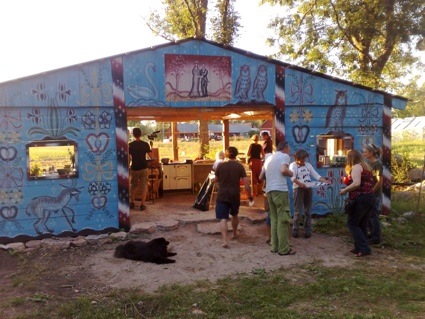
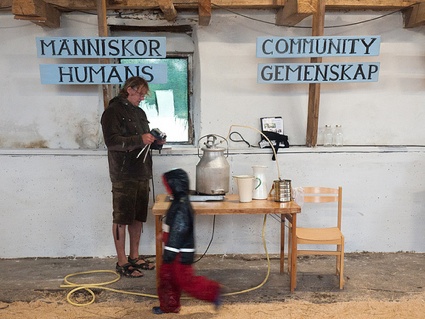
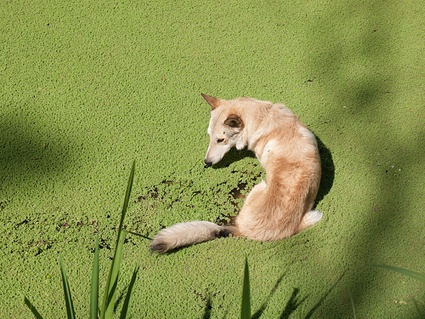 Images Kultivator from the series Wedding between art and agriculture
Images Kultivator from the series Wedding between art and agriculture
I discovered KULTIVATOR a couple of years ago at Pixelache in Helsinki. The collective was founded in 2005 by 3 artists and 2 organic farmers in the village Dyestad, on the Swedish island of Öland. This cooperation of farming and visual art practice involves an organic farm with where pigs are raised, cows are milked, potatoes are harvested and linseed oil is pressed. But KULTIVATOR is also a space for artist residencies, exhibitions, performances, installations and screenings. And in between are activities that draw in both the artist and the farming community. The result looks both experimental and remarkably productive.
Malin Vrijman, one of the founding members of Kultivator, was kind enough to answer my many questions:
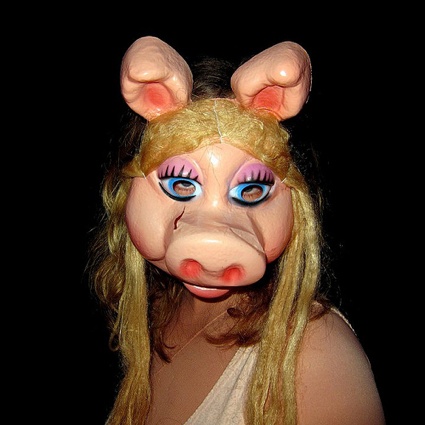 Wedding masquerade
Wedding masquerade
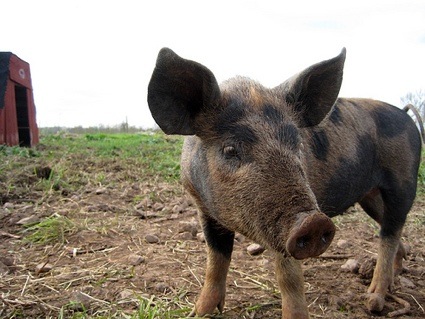 Dyestad farm pig
Dyestad farm pig
In an interview for publik.dk, you said that there are many similarities between the way you live and work as artists and how an organic farmer live and work. Could you give us more details about this?
When we came to live close to the farm, we discovered that both we as artists and the organic farmer were struggling with “companies”, or enterprises, that are based on cultural resp., ecological calculations as well as the usual economical one, and that this sometimes clashes. For example, when the EU farm subsidies suddenly changes and the farm has to adapt (or just suffer), or the art money gets directed differently and we must adapt (or just suffer). We both have offices full of unwanted paperwork… And we both always go for this cultural and ecological conviction in the end anyway because it´s the only thing that makes sense. Since the reason that we are publicly funded must be that we take responsibility for those two things first.
Another parallel that we’ve talked about is like a shared frustration over being exclusive, when we rather would like to be accessible, mainstream, or whatever you call it. Like in the organic farm shop where people come from the city and they buy two peppers, and one small melon, instead of 10 kilos of potatoes. Or in a museum art show that only a certain small crowd visits. As if art and good food are luxury things, when they should belong to everybody. Another similarity is that most people have their own idea about what a farmer does, and also what an artist does, and it’s usually very far from today’s reality. Both occupations are in fact alienated from people as it is now.
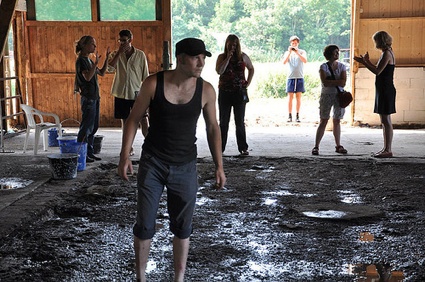 But even more interestingly, what did you bring to each other? I can easily imagine that it’s handy to have an organic farm nearby for an artist studio but what does the agriculture community get from having artists on their land? Which form(s) take(s) your collaboration/cohabitation?
But even more interestingly, what did you bring to each other? I can easily imagine that it’s handy to have an organic farm nearby for an artist studio but what does the agriculture community get from having artists on their land? Which form(s) take(s) your collaboration/cohabitation?
OK, it is right that for the artists-residency, it is ideal to be able to produce the food for everyone, and for visiting artists to use the farm and farmers as inspiration and information source.
But the benefit is not one way – when we get this question (and we often do) Henric’s answer is always the same;”The good thing is, that there are people around”. It may seem like a small thing, but I think it is not. When Henric’s grandparents ran the farm, five families lived and worked on it. And there were six farms like that in the village. Now Henric’s (Kultivators) is one out of two, and the owner of the other farm lives elsewhere. Last year alone something like 30 artists have stayed here, for longer or shorter periods, plus visitors and schools, parents of the kids, etc. It gives life and energy to the agricultural community that in our part of the world is getting almost dangerously lonely.
So when the cows escape, when a calf is stuck, when there is slaughter or harvest or forest work, there is always helping hands nearby. Collecting and preparing food is an incorporated part of living here, and this means helping out. Of course, parties, dancing, evenings discussing world politics by the fire is enjoyed from both sides…
This was also the reason why we arranged the marriage between art and agriculture last year. We want the discussion of what would be the future of agriculture, ethical concerns when it comes to keeping animals and exploiting land, etc, to go on not only between farmers and intellectuals separately, but in meetings between the two. This is the direct way, here in the village. In more general way, we have been asked to sit on the cultural board of the Swedish farmers union, LRF, that has as objective to support quality culture in rural areas, and to make farmers and farms visible and present in the cultural life as a whole. This corresponds of course very well with what we want, and what we think is beneficial both for the farming and the rest of society.
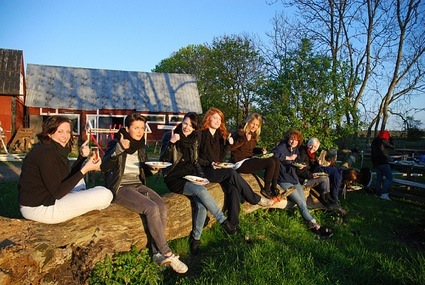 Glocalguide. Image Kutivator
Glocalguide. Image Kutivator
Kultivator offers residencies to artists but also works with the local community such as schools. Which kind of activities do you organize with or for people living in the area?
We always invite public to come and meet and see results from the visiting artists at the end of their stay. Once a year, at the Harvestfeast, we make like a summing up of the year, and stay open all night. Then we have also made a few projects directly addressing the nearby area, like the Souvenir of Öland competition, where we asked people to imagine and produce a new souvenir for the island, and the Glocalguide, were we restored an ancient walking path and made an online guide to it, with local stories and facts from people in the neighbourhood.
With schools we always have very hands on work, which often stays as part of our “place”. It can be to build a mobile chicken house, construct an outdoor shower, make a picnic place, etc. We have had very nice nature walks with students and immigrants recently arrived to Sweden, where students give an introduction to Swedish right of public access to nature, and what berries and mushrooms you can pick and so on.
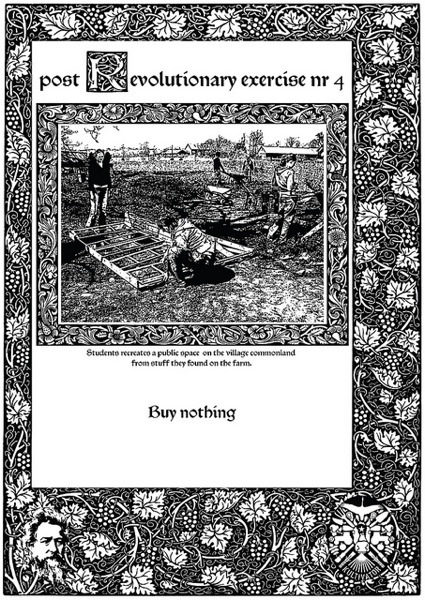
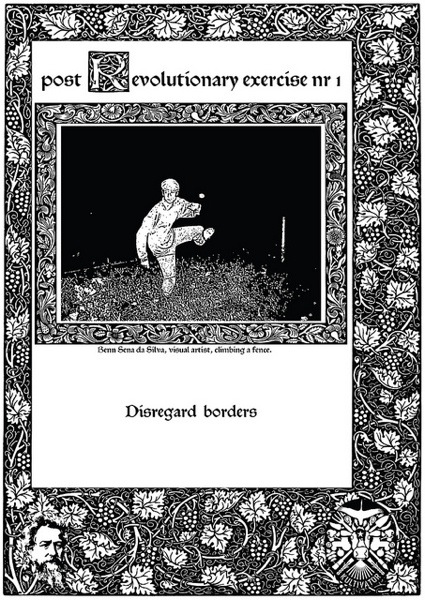
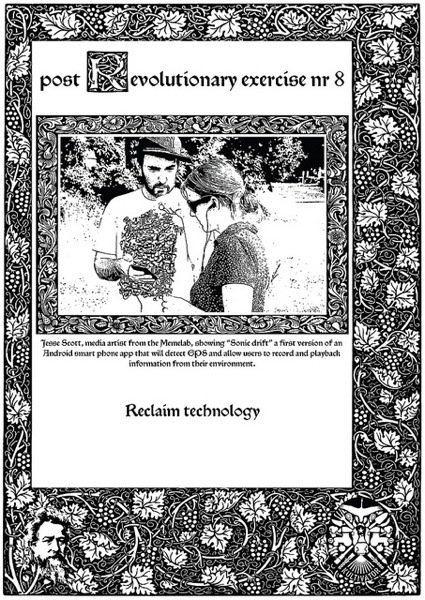 post (r)evolutionary exercises Images Kultivator
post (r)evolutionary exercises Images Kultivator
What are the ‘post (r)evolutionary exercises’? For whom are they intended? I’m also curious about their design. Does the particular aesthetics refer to past movements?
The post (r)evolutionary exercises are the outcome of a meeting/friendship/project that started in summer 2010, when we took part in “Goings on” seminar in Beirut, Lebanon. In this seminar, curated by Cecilia Andersson, Scandinavian and Middle east art groups were invited to meet and learn about each others practices. That’s what we did, we got along really well, and we started at once to think of ways to do something together again. After the seminar, The Danish group rum46 applied for money to get everyone to Denmark and Sweden in summer 2011, in a project called Camp.
Then in between, as we know, the Arabic uprising came – our new friends stood on the Tehrir square, or struggling in Damascus and so on, and we felt that when they came to us, that is what we wanted to talk about; What now? What do you do after the revolution? We wanted some kind of physical outcome of the talks, and choose posters, also so that we could distribute them to the people taking part afterwards. And then finally, in August 2011, when everybody (except sadly, the Syrian group that did not dare to travel because of the violence in Damascus) had arrived and were gathered on the farm, we all as usual began to do “the farm things”, (like slaughtering, fencing, milking, etc,) someone came up with that “this is actually what you must do after the revolution”; building up again. So we discussed, and sketched, and identified these “exercises”. Intended for anyone who hopes to live through a revolution. They are illustrated with pictures from projects we have made, some from the actual meeting that summer with the Middle East art groups, and some from previous events taking place on the farm.
And yes, we took the design from a manuscript of William Morris, the radical frontiers person of the Arts and crafts movement in the late 19th century in England. Nowadays, these patterns are popular interior decorative, but then they represented a criticism on industrialisation and its enslavement of the masses. It had nothing to do with bourgeoisie or elitism, just like we don’t believe that art or farming should be elitist, or conservative. I suppose the design kind of underlines this contradiction on the surface, to be radical and yet traditional. We like to play with that.
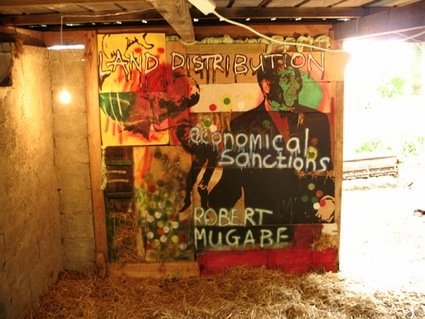
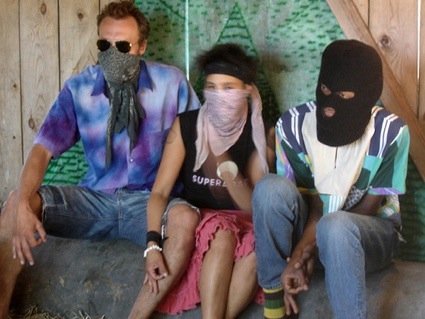 El Parche. Images Kultivator
El Parche. Images Kultivator
Could you tell us about some of the most exciting works developed during artist residencies at Kultivator?
Well…this is hard to choose. One piece here on site that has meant a lot for us is the Cambuche, an installation by Colombian/Namibian/Norwegian group el Parche, members Olga Robayo, Herman Mbamba, Marius Wang. They build up this favela housing structure here, from farm waste, and provided it with visual kind of street art stories of the Robert Mugabe land reform act and the USA/Monsanto war on drugs (and small farmers) in Colombia. It became a place here on the farm to reflect on “another side of farming”, that can be easily forgotten in our idyllic countryside. For us it has been an important part of the communal thinking that has shaped our practice into what it is, or heading towards.
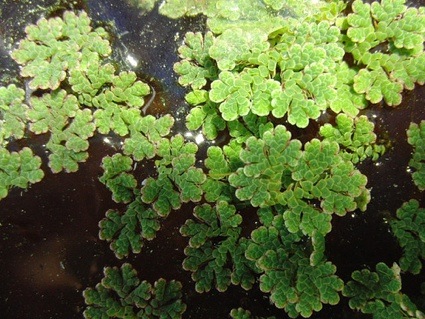
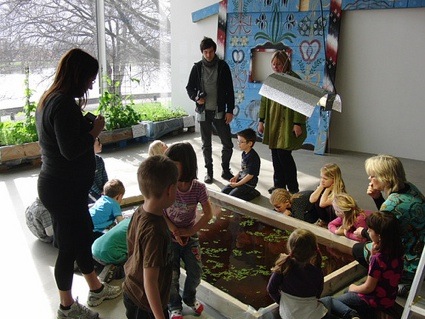 Supermeal Azolla installation. Images Kultivator
Supermeal Azolla installation. Images Kultivator
Another very exciting work we have been happy to host is Super Meal by Erik Sjödin that investigated the Asian water fern Azolla. The plant had been explored by NASA, as a possible future space crops, due to its enormous growth and great nutrition value. Erik planted it here in our biopool, that cleans water from the farms up streams, and it really did grow enormously, (by this cleaning the polluted water) and was eaten with great appetite by our pigs and chickens, and used as fertilizer in the raised beds of the garden. For the Wedding between art and agriculture, Erik also cooked it, and served together with his fascinating story of the might-be-saver-of-the-planet plant.
Others, like French/Indian dancer and martial arts performer Keity Anjoure came with their own poetic research, in her case over the relation between people and trees, that resulted in a video of her climbing our big old oaks with a soft, ten meters-high silage plastic ladder.
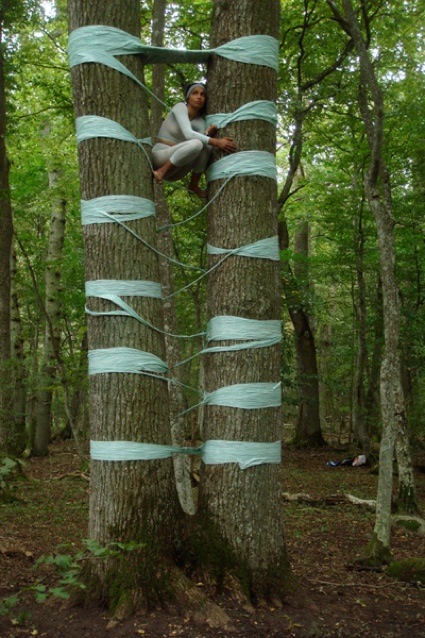 Photo from the performance Urgent Secret! by Keity Anjoure
Photo from the performance Urgent Secret! by Keity Anjoure
I must also mention the work for the Android smartphone app “boskoi”, made by Theun Karelse this Summer. He biked around and mapped out more than 60 different wild apple trees in the surrounding of our farm. They can now be found with the help of the boskoi app, which is a world wide communal inventory of edible plants.
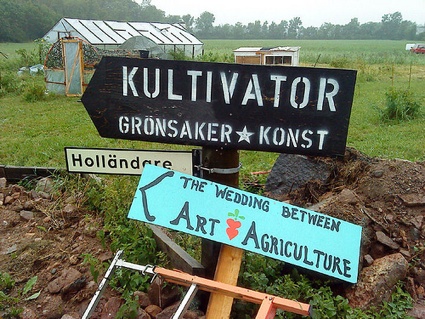
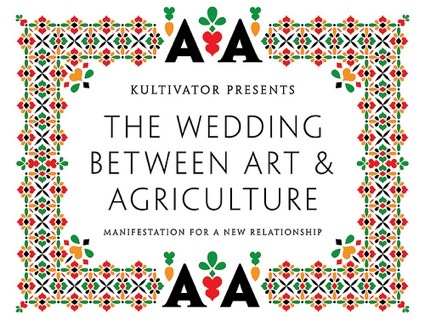
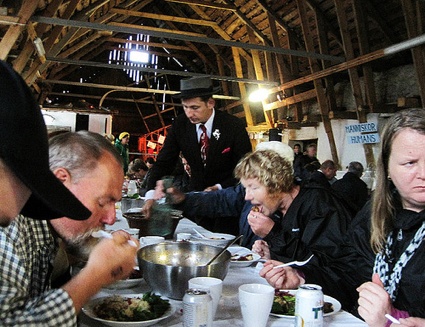 Wedding between Art and Agriculture, images Kultivator
Wedding between Art and Agriculture, images Kultivator
I’m very interested in the Wedding between Art and Agriculture which took place in 2010. A year and a half after the happy day, would you say that this is a happy, fruitful marriage?
It is a happy, fruitful marriage, but more than that, it is serious…. When we arranged it, we called it a re- marriage, and meant that these two human activities had been very closely connected back in history, and only recently been separated. For everybody´s best they needed to go back to each other again. Something in the time we live in wants this, there is a lot of initiatives that shows that. Like people who are developing creative, poetic farming, look at Detroit, or the rise and organisation of small farmers in Africa and the Campesinos in South America. And I also mean all the interest in farming projects from the urban art world. I have seen big exhibition projects every year over the last years in every big city that deals with food production and farming in some way. This was certainly not the case seven or five years ago.
Maybe one could say that this going back together at this point is not really happening out of love, but out of necessity, pure survival. It is a good old fashioned arranged marriage. Then again, what comes first, love or need?
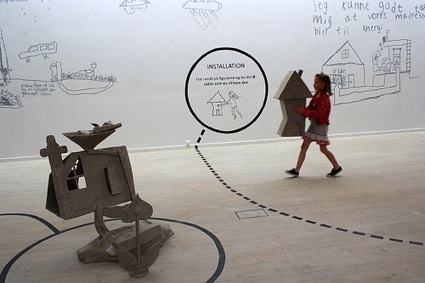
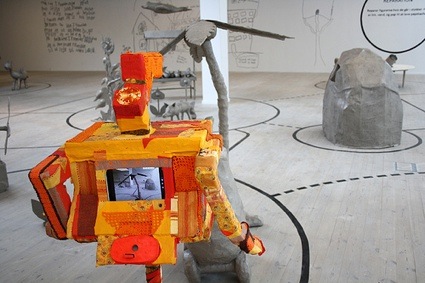 Imagine Farm. Photos Kultivator
Imagine Farm. Photos Kultivator
In Europe at the moment we are experiencing recession, all sorts of crisis and there is a sense of fear for what tomorrow will bring. What has the Kultivator experience and projects like ‘Imagine Farm’ taught you that might be applied to the time we are living? I wondered if you had lessons to share about for example, self-sufficiency, relationship to nature, other living creatures, sharing, etc?
What it has taught us…This is a question that can have so many answers. To begin with, the Kultivator initiative comes out of a wish for something less catastrophic than today’s society… We try all the time in what we do to promote, or discuss ways to achieve a sustainable, creative and social way of living. This is what we start with. The big learning experience from working with the projects we have been doing, that we took up and elaborated in Imagine farm, is that cooperation, sharing and discussing visions are crucial things to improve if we want to reach this.
The whole Imagine farm project was an attempt to create a communication tool/situation, where it was possible for kids to play with the future, and show others, over generation borders, what they were thinking and what they wished for. All imaginations of the future that we worked with were from a positive point of view, only focus on what the kids wanted, not what they were afraid of. This we had asked especially for, to avoid the usual guilt and sacrifice carousel that we too often put our kids and ourselves in when talking about the future.
I can’t say that the futures the kids visualized were a surprise. They wanted, not unexpectedly, and also not unreasonably, a peaceful, just, and clean world. It is stating the obvious, but that should be like the most heavyweight policy document that there is. Not one thing of all the things we think that it is OK to compromise peace, or justice, or cleanness for, was on their list. And, (again stating the obvious) they are the ones, not us, that will live the future.
We have in general, by all our practical experiments, realized that it is much easier to collaborate than we are brought up to believe. In the present western individualist worldview, the cooperation between for example the farmer and the artist is hopeless, since the practicality of the first will kill the poetry of the latter, and the other way around. But what we experience again and again is that these two aspects together takes ideas and progress further than if they were alone and specialized. Working with more than a hundred children, like in Imagine farm, also showed that if we only put some effort in creative systems to work and think together, we can do almost impossible co operations. Maybe naively we think that the relation with the rest of the ecosystem will work out fine, if we manage to have fair and fruitful relations to each other.
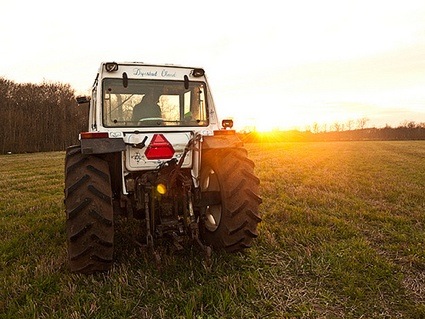 Wedding tractor. Image Kultivator
Wedding tractor. Image Kultivator
Any upcoming projects Kutivator could share with us?
We have a lot of very nice collaborations going on this spring, now in February we travel to Kirkenes and the Barents Spektakel in Norway, to make another Crosscultural Nomadic cheese, with milk from the bordering countries Norway, Russia and Finland. We work with a new kids – future project in Gnesta, Sweden, and some more exhibitions, seminars and residencies. We also work here on our long – term project the farm, of course, with building an earthhouse, and establishing more of a perma culture garden, to in the end go for self sufficiency for us and our visitors.
We also have another big new project, or direction, still in its very beginning, that we call “The Grandmothers University”, with inspiration from Vendana Shivas Navdanya center in India. This will be an exploration into concepts of learning and practicing, and what forms an effective exchange between generations could take. We have some very interesting partners for this, but it is a bit early to announce all details. We are just starting up…Hopefully we can come back on that!
Thanks Malin!
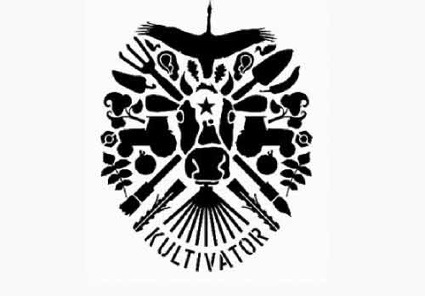
All images courtesy Kultivator.
Previously: Herbologies/Foraging Networks at Pixelache Helsinki and Azolla Super Meal.
